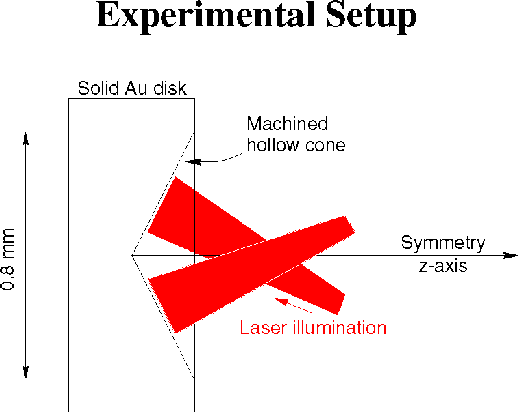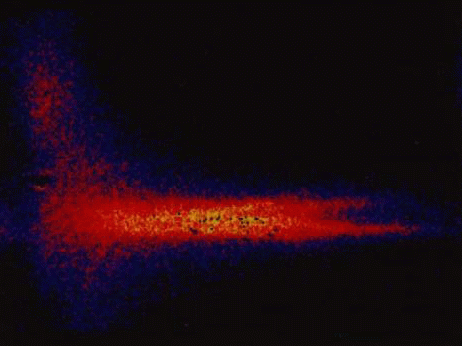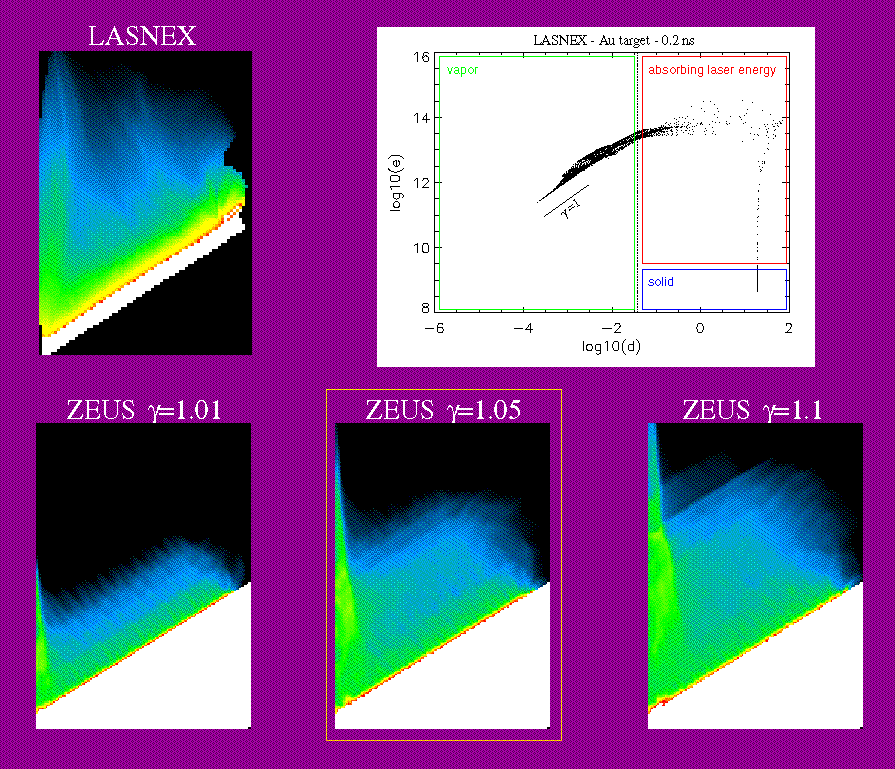
Protostellar jets and outflows are strongly cooled by optically thin radiative emission. Moreover, they are high Mach number, and generally overdense compared to their surroundings (see the Protostellar Jets and Outflows research page). Recently, ultra-intense (terawatt) lasers have been used to produce jets with these same properties, allowing astrophysical jets to be studied directly in the laboratory.
The work shown here has been done in collaboration with Neal Turner, Bruce Remington and his group at LLNL (especially Kent Estabrook, Dave Farley, and Gail Glendinning), and K. Shigemori.
The image below shows the experimental setup. The laser beams are focused on a small gold target in which a cylindrical cone has been machined. Ablation of gold from the target produces a plasma flow to the right. Initially the flow is perpendicular to the surface of the cone. But by symmetry the flow converges onto the axis, generating a narrow dense jet.

 The image on the right shows a radiograph of the emission from the jet
a few nanoseconds after the laser is switched on. The high density
and temperature of the ablated material as it converges onto
the symmetry axis increases the radiative cooling rate.
The image on the right shows a radiograph of the emission from the jet
a few nanoseconds after the laser is switched on. The high density
and temperature of the ablated material as it converges onto
the symmetry axis increases the radiative cooling rate.
In fact, the radiative cooling time becomes less than the dynamical
time (as it is in astrophysical protostellar jets), and a true
radiative jet is produced. Radiative cooling decreases the width
of the jet, and produced a
"limb-brightened" emission by the cylindrical geometry and the lower
central temperatures.
More detail can be found in the following paper:
``A Radiative Jet of Astrophysical Interest Produced at the Nova Laser Facility", by D.R. Farley, K.G. Estabrook, S.G. Glendinning, S.H. Glenzer, B.A. Remington, K. Shigemori, J.M. Stone, R.J. Wallace, G.B. Zimmerman, & J.A. Harte, Physical Review Letters, 83, 1982 (1999).Laboratory experiments in the physical regime appropriate for radiative astrophysical jets can be used to test numerical models computed by astrophysics codes. These tests might suggest improvements in the numerical algorithms, which can then be used for more complex problems that cannot be replicated in the laboratory.
 The image on the left
shows the results of several test calculations
using the ZEUS astrophysics code of the
Nova laser experiment described above. Snapshots of the density
in the ablated flow are shown for several different values
of the adiabatic index of the gas. In the upper left panel a result
from the LASNEX plasma dynamics code is shown as well.
Only models which have an adiabatic index close to one match
both the experimental results and the LASNEX simulation.
Click on the image to download a full-sized version.
The image on the left
shows the results of several test calculations
using the ZEUS astrophysics code of the
Nova laser experiment described above. Snapshots of the density
in the ablated flow are shown for several different values
of the adiabatic index of the gas. In the upper left panel a result
from the LASNEX plasma dynamics code is shown as well.
Only models which have an adiabatic index close to one match
both the experimental results and the LASNEX simulation.
Click on the image to download a full-sized version.
We are testing numerical models computed using ZEUS with a more complex formulation for the radiative cooling rate against the radiative jet and other laser experiments.
More detail can be found in the following paper:
``Testing Astrophysical Radiation Hydrodynamic Codes with Hypervelocity Jet Experiments on the Nova Laser", by J.M. Stone, Neal Turner, K. Estabrook, B. Remington, D. Farley, & S.G. Glendinning, The Astrophysical Journal Supplements, 127, 497 (2000).